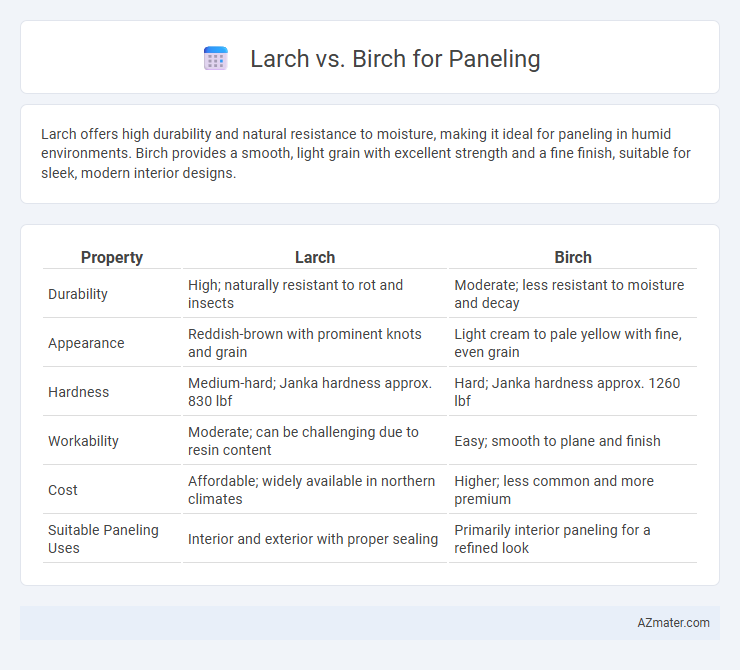Larch offers high durability and natural resistance to moisture, making it ideal for paneling in humid environments. Birch provides a smooth, light grain with excellent strength and a fine finish, suitable for sleek, modern interior designs.
Table of Comparison
| Property | Larch | Birch |
|---|---|---|
| Durability | High; naturally resistant to rot and insects | Moderate; less resistant to moisture and decay |
| Appearance | Reddish-brown with prominent knots and grain | Light cream to pale yellow with fine, even grain |
| Hardness | Medium-hard; Janka hardness approx. 830 lbf | Hard; Janka hardness approx. 1260 lbf |
| Workability | Moderate; can be challenging due to resin content | Easy; smooth to plane and finish |
| Cost | Affordable; widely available in northern climates | Higher; less common and more premium |
| Suitable Paneling Uses | Interior and exterior with proper sealing | Primarily interior paneling for a refined look |
Introduction: Larch vs Birch Paneling
Larch paneling offers exceptional durability and natural resistance to moisture, making it ideal for both indoor and outdoor applications where longevity is crucial. Birch paneling provides a smooth, fine grain and pale color, creating a bright, modern aesthetic suited to contemporary interiors. Choosing between larch and birch depends on the desired balance of robustness and visual appeal in paneling projects.
Botanical Overview: Larch and Birch Species
Larch (Larix spp.) is a deciduous conifer known for its needle-like leaves that turn golden in autumn before shedding, with species such as European Larch (Larix decidua) and Western Larch (Larix occidentalis) commonly used in paneling due to their durability and resistance to decay. Birch (Betula spp.) features broad, simple leaves and smooth bark, with species like Paper Birch (Betula papyrifera) and Silver Birch (Betula pendula) favored for their fine grain and pale color, ideal for decorative interior paneling. Both genera offer distinct aesthetic and structural qualities, influencing their selection based on desired texture, grain, and environmental durability in interior design.
Appearance: Grain, Color, and Texture Comparison
Larch paneling displays a distinct, knotty grain pattern with warm, reddish-brown hues that darken over time, offering a rich and rustic aesthetic. Birch paneling features a smoother, finer grain with a lighter, creamy color that provides a clean, contemporary look. Both woods present unique textures; larch has a coarse, rugged feel while birch is generally softer and more uniform, making them suitable for different interior design styles.
Durability and Strength
Larch wood offers exceptional durability and strength, making it highly resistant to rot, insects, and harsh weather conditions, which is ideal for paneling in high-traffic or moisture-prone areas. Birch, while strong and dense, is less resistant to decay and may require additional treatment to enhance its longevity for paneling purposes. Choosing Larch ensures long-term structural integrity and minimal maintenance compared to Birch in interior and exterior paneling applications.
Workability and Installation
Larch wood offers excellent workability due to its fine grain and natural durability, making it easier to cut and shape for paneling installation compared to birch. Birch, while harder and denser, requires more precision and sharper tools during installation to avoid splintering but provides a smooth, even finish once installed. Both woods offer good stability, but larch's natural resistance to moisture gives it an edge in paneling applications where ease of handling and installation speed are priorities.
Resistance to Moisture and Decay
Larch wood demonstrates superior resistance to moisture and decay compared to birch, making it an ideal choice for paneling in damp or humid environments. Its dense, resin-rich composition helps prevent water absorption and fungal growth, extending the lifespan of the panels. Birch, while aesthetically pleasing, is more prone to swelling and rot when exposed to moisture, requiring additional treatment or sealing to enhance durability.
Cost and Availability
Larch paneling tends to be more cost-effective than birch, offering durability and a warm, reddish tone ideal for rustic and modern interiors. Birch paneling, while generally more expensive, provides a smooth, pale finish favored for sleek and contemporary designs. Both woods are widely available, but larch has greater regional abundance in Northern Europe, whereas birch is more commonly sourced from North American suppliers, affecting pricing and lead times.
Environmental Impact and Sustainability
Larch wood, known for its durability and natural rot resistance, offers a sustainable option for paneling due to its fast growth rate and carbon sequestration properties. Birch, while less naturally resistant to decay, is often sourced from managed forests with certifications like FSC, ensuring responsible harvesting and regeneration practices. Both species provide environmentally friendly choices, but larch's longevity and lower maintenance reduce the need for chemical treatments, minimizing its overall ecological footprint.
Best Uses and Design Aesthetics
Larch wood offers rich, warm tones and high durability, making it ideal for rustic or traditional paneling that requires natural resistance to moisture and wear, perfect for saunas or exterior walls. Birch provides a lighter, more uniform grain with smooth texture, suited for modern, minimalist interiors and painted finishes due to its fine surface and pale color. Choosing between Larch and Birch depends on the desired aesthetic impact and the environmental conditions where the paneling will be installed.
Conclusion: Choosing Between Larch and Birch Paneling
Larch paneling offers superior durability and natural resistance to moisture, making it ideal for areas with higher humidity or potential wear. Birch paneling provides a smooth, light finish with consistent grain, perfect for creating a bright, modern aesthetic. Selecting between Larch and Birch depends on balancing the need for resilience against aesthetic preference and interior design goals.

Infographic: Larch vs Birch for Paneling
 azmater.com
azmater.com